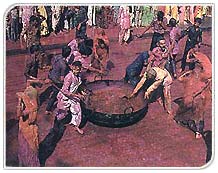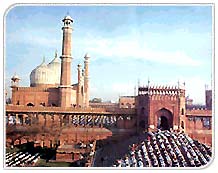Cultural India
Cultural India Home » People » History » National Anthem » National Animal » National Tree » Fairs & Festivals
Physical Features » National Emblems » National Bird » National Fruit » Religions » Languages
National Flag » National Flower » Air Line Ticketing » Map of India » Travellers Tools
---------------------------------------------------------------------------------------------------------------------------------------------------------------------------------------------------------------------------------
Fairs & Festivals
September | October | November | December
March Fairs & Festivals
 HOLI
HOLI
(All over North India)
Is the most boisterous of all Hindu festivals, observed all over the North.
It heralds the end of winter and the beginning of the Spring. The night before
the full moon, crowds of people gather together and light huge bonfires to
burn the residual dried leaves and twigs of the winter. People throw coloured
water and powders (gulal and kumkum) at each other and make merry. Singing
and dancing add to the gaiety of the occasion. In the northern, western as
well as eastern regions, Holi celebrates the joyful raasleela of Krishna and
the gopis. They play phag which is a game of many colourful hues. It is a
joyous celebration of the rejuvenation of nature, and renewed hope of happiness
and peaceful coexistence. Especially famous is the Lathmaar Holi of Barsana
and Nandgaon. In Anandpur Sahib, Sikhas celebrate a special festival Hola
Mohalla on the day after Holi . It marks a display of ancient martial arts
and mock battles. Holi is also an occasion for the celebration of the burning
of Kama, the Hindu cupid, with the fire that emanated from Lord Shiva's third
eye.
GANGAUR
Is dedicated to Gauri, a manifestation of Goddess Parvati and lasts for 18 days. The festival is celebrated girls and married women throughout Rajasthan. The images of Gauri are ornamented and offerings are made. This is also and auspicious day for young people to select their life partners. Colourful processions with the town band playing, horses and elaborate palanquins make it a fascinating spectacle.
JAMSHED-E-NAVROZ
The Parsis don their new clothes and decorate their homes with rangoli patterns drawn with metal moulds and flowers. Sweets are exchanged and later Parsis visit the fire temple where thanksgiving is performed.
RAMNAVAMI
(All over India)
The birthday of Lord Rama, the celebrated hero of the famous epic, the Ramayana,
is enthusiastically celebrated on the ninth day of the waxing moon in the
month of Chaitra. Temples are decorated, religious discourses are held and
the Ramayana is recited for ten days. People gather in thousands on the banks
of the sacred river Saryu for a dip. People sing devotional songs in praise
of Rama and rock images of him in cradles to celebrate his birth. Rathyatras
or chariot processions of Rama, his wife Sita, brother Lakshmana and devotee
Hanuman, are taken out from many temples.
 ID-UL-ZUHA
ID-UL-ZUHA
(All over India)
Is a muslim festival celebrated all over India. Prayers are offered in the
mosques and special delicacies are prepared and served among family and friends
on the occasion.
MAHAVIR JAYANTI
(All over India)
The birth anniversary of the 24th Tirthankara of the Jains, Mahavir, the founder
of Jainism, is celebrated by the Jain community. Lectures are held to preach
the path of virtue. People meditate and offer prayers. Donations are collected
to sace the cows from slaughter. Pilgrims from all parts of the country visit
the ancient Jain shrines at Girnar and Palitana in Gujarat, on this day.
KHAJURAHO DANCE FESTIVAL
(Khajuraho, Madhya Pradesh)
Is a week-long festival of classical dances held at the Khajuraho Temples,
built by the Chandella Kings.
ELEPHANT FESTIVAL
(Jaipur, Rajasthan)
A festival where elephants are the centre of attraction. They stride majestically
parading their decorated trunks and tusks. The festival begins with aa procession
of elephants, camels and horses, followed by lively folk dancers at their
entertaining best. Elephant races and elephant-polo matches are special features.
The most hilarious highlight of the festivals is a tug of war between elephants
and men.
HOYSALA MAHOTSAVA
(Karnataka)
Is a dance festival held at the Hoysala temples of Belur and Halebid in Karnatka.
ELLORA FESTIVAL
(Ellora caves, Maharashtra)
Is a festival of dance and music organised in the splendid surroundings
of the magnificent Ellora caves.
Physical Features » National Emblems » National Bird » National Fruit » Religions » Languages
National Flag » National Flower » Air Line Ticketing » Map of India » Travellers Tools